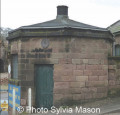(A) In 1817 this was The Red Lion Inn. The Hampden Club met here. Set up in 1816, calling for parliamentary reform and manhood suffrage, these political clubs gained wide support among working people. They presented a petition to Parliament with half a million signatures but were broken up and driven underground by March 1817.
(B) The vicar of Pentrich Rev. John Wood of Swanwick Hall sponsored by the Duke of Devonshire called for the church to be built in 1820 to eradicate ‘the remaining seeds of sedition and disaffection’ .On your right is the Old Cock Hotel. The Hampden Club held its first meeting here. Cobbett's ‘Register’ and the radical ‘Nottingham Review’ were read aloud and grievances discussed. The main talk initially was of petitioning parliament; more radical methods were discussed as repression continued. Also on Church Street was also the former ‘dissenters chapel’ of the Primitive Methodists.
(C) Facing you across the street is number 26 Chapel Street, on the corner with Greaves Street. This house was where Charles Booth, the last survivor of the Revolution was living when he died in 1896, almost reaching the grand age of 100. He gave much detail for John Neal’s book. ‘The Pentrich Revolution.’
(D) Pass Wood Street on your left where the Wood Street Methodist Church was attended by Charles Booth and the Walters family who took part in the rebellion. Methodists played an important role in local radical activity - Isaac Ludlam of South Wingfield, executed in Derby, had a significant reputation as a Methodist preacher. John Cope, a fettler at the Butterley Works, who joined the Hampden Club and was introduced to radical politics by a fellow worker Thomas Bacon, came this way to secret meetings to discuss the rising at Asherfields Barn outside Pentrich, during May and early June 1817.
To the left, is the entry to Padley Hall. The rebels visited here on their march and Charles Walters, servant of the owner George Argyle, hid in his master's blanket chest, was found and forced to join the insurgents. The housing on both sides was built for workers at Butterley from the 1820s onwards. Hammersmith House, formerly the Butterley Company manager's house, is on the right as you walk up Butterley Lane.
(E) This is the route taken by the marchers as they came from Pentrich on the night of 9th June 1817. The Butterley Ironworks, founded in 1790 by Benjamin Outram, used local iron ore, limestone and coal. A major employer in the area in 1817 it was to grow into firm of national importance. While some workers from here joined the Hampden Club, few joined the march to Nottingham in June. Radicals like Thomas Bacon had been dismissed and, as John Cope thought, workers here were too well paid. But the rebels hoped to seize the supply of guns and ammunition from the works, and Bacon talked of whether cannon could be made in the foundry. The marchers stopped here, in the early hours of Tuesday morning. The manager, Mr Goodwin, and a few special constables, refused to hand over guns and ammunition held in the works. Mr Goodwin recognised many of the insurgents as former employees and was an important witness at the Derby trial in October. The rebels marched on towards Codnor.
(F) In 1817 this area was not built up. An ‘isolated house’ of a Thomas Brassington was used as a meeting place for the Hampden Club after the government in April 1817 banned them. Here John Cope held meetings of his ‘political club’ from the Butterley Works, reading Sherwin's pamphlets to the group of workmen.
(G) The 1835 map on the board gives a good account of this area at the start of the 19th century.
(H) Men from Ripley and Heage came to this area as they marched towards Codnor to join the rest of the rebels. As they passed through this area of Greenwich they stopped at farms and houses demanding weapons and pressed men to join the march. All marchers from Ripley escaped transportation or execution.














